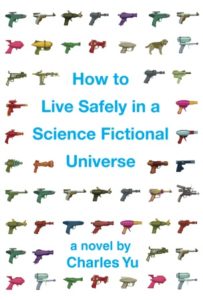
Charles Yu’s How to Live Safely in a Science Fictional Universe begins with a “chronodiegetical schematic,” a theoretical chart that maps two different approaches (tense vs. tenseless) to time, and how different it is to live in each of them. The book is divided into “modules” using the Greek alphabet (starting with alpha) and includes footnotes, algorithms, white space, and a complex diagram of a “time loop.” The protagonist, a young man who happens to be named Charles Yu and is also the author of a mysterious book, has a job repairing time machines. He is accompanied by Ed, an imaginary but “ontologically valid” dog plus TAMMY, an operating system with low self-esteem. (It comes as a surprise that she is not the one writing novels).
The setting is sometime in the future, in a somewhat bleak, possibly post-apocalyptic location called Minor Universe 31, where major tectonic shifts leave many places inhabitable, and the world is run by corporations—perhaps only slightly more than it is now. The capital city, which is home to more than eighty percent of the population, is a place called Lost Tokyo (the original city ruptured into two pieces), a fairly workaday place where lonely sexbots roam the streets.
But How to Live Safely is not science fiction in a Ray Bradburyish way. Just like its timid, somewhat unsure narrator, the novel does not take itself or its conceits too seriously. There is a certain amount of wink-wink from the author, which is in keeping with the story’s exploration and limit-testing—why else would there still be video stores in the future? The novel is also suffused with radiant sweetness, allowing the cold science and engineering to be warmed by real emotion. Like yin and yang, the author’s whimsical, imaginative technical creations balance out what could be an overly familiar coming-of-age immigrant story. In fact, when hard technical and scientific language are used to render emotion and atmosphere, it makes for some of the best writing in the book:
The house became charged, a field of static potential energy, a kind of vectorless disappointment, a field of invisible isovoltaics, lines with arrowheads pointing in minute directional indicators, a bogglingly complex arrangement of single-point losses, the fine-toothed, fine-pixeled array, the heat map of a thermodynamic system whose ending was already foretold in the current steady state.
This concept is at once futuristic and simultaneously mundane. Underneath the bleeping trappings of science fiction is a domestic drama: immigrant family, fighting parents, middle-aged father with failed dreams, sensitive son, mother in denial. But it is also a meta-place where the protagonist Charles Yu, getting out of his time machine, confronts another Charles Yu from a different time—and shoots him; the first Charles Yu must face the fact that his future will inexorably bring him back to this moment where he will be shot dead by himself. Much of the novel thus serves as an extended mediation on the nature of time.
Eventually, the father, who has invented the concept of a time machine but has failed to construct one that actually works, suddenly disappears. The mother falls into what we could call depression, choosing to spend the rest of her life in an endless time-loop replaying a happy, if fictional, family memory. The Charles Yu character then uses his own time machine to travel into the past in an attempt to understand why his father left.
As its most basic level, How to Live Safely explores the very human urge to return to the past and fix things—but in Minor Universe 31, the protagonist can literally return to the past. It’s a clever device that allows the protagonist to minutely examine his history (with helpful commentary by TAMMY, the operating system) and, in the process, to learn a lot about himself.
Since I teach a course called “Ethnic Writing,” my students will invariably ask, “Is this an ethnic novel?” Aside from the Chinese surname of the author/narrator, within the text all aspects of the protagonist’s identity are coyly kept vague:
I learned grammar from my mom… she was not a native speaker, hadn’t even learned English until she immigrated here. She, like my father, had come from that little island in reality, where they spoke their language, a home language, a private family language as well as the mainland language taught in schools by the nationalists.
I would aver that this is, to some degree, a book about ethnicity and immigration, but instead of writing a decidedly quote-unquote ethnic narrative, with all sorts of cultural inside jokes and exotic food in italics, Yu has used a new form to make a very familiar story seem fresh.
Yu’s first book, a collection of stories titled Third Class Superhero, was similarly inventive, dealing with a superhero whose power is basically useless: he can conjure up gentle streams of water. The characters in both works are tentative, shy about taking up space and time, eaten by worry. If I have any quibble with How to Live Safely, it’s that I wish the author had gone even further, wilder, in his imaginings. But I felt that way only because his writing had already brought me as far into this world as it did, and his willingness to take risks charmed and intrigued me.




